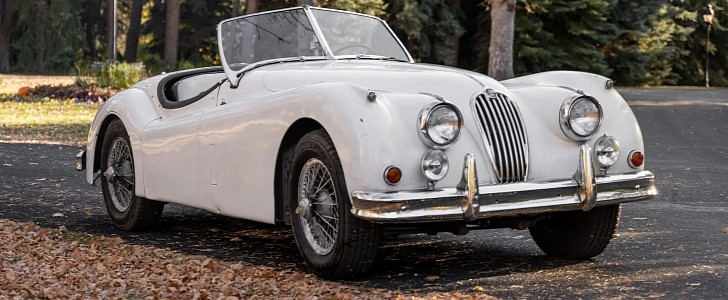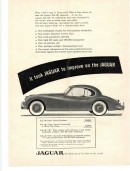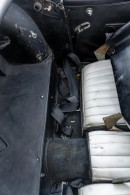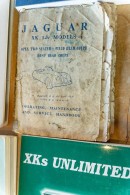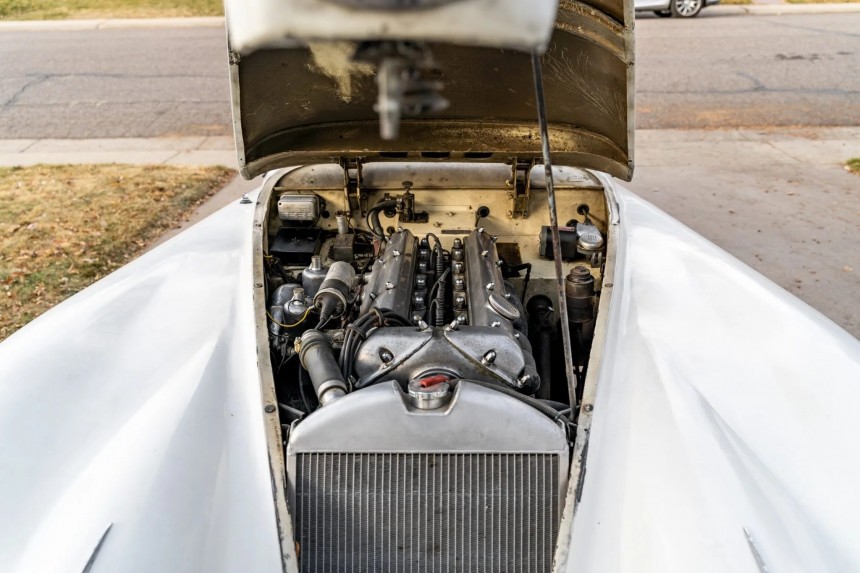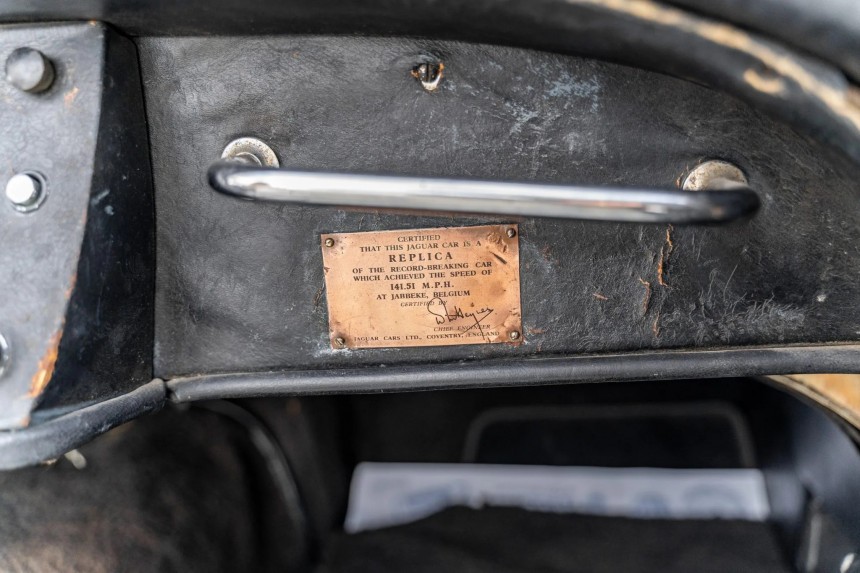The phenomenally successful XK120 made Jaguar a household name in the world of sporty cars. Completely in line with the grace-space-pace mantra of the British automaker, the XK140 followed in the footsteps of its predecessor with better everything, starting with chassis tidbits.
A body-on-frame sports car like the XK120 it replaced, this fellow is joined at the hip to the Mark V sedan and coupe. Although it shares the 2,591-millimeter (102-inch) wheelbase with the XK120, the front bulkhead was moved forward to create more legroom for both driver and passenger. In terms of suspension technology, Jaguar upgraded to rear telescopic shocks compared to the lever arm shocks of yesteryear. Suspension travel was increased as well because UK roads weren’t particularly up to snuff.
Introduced in October 1954 at the London Motor Show, the XK140 can be considered a heavy facelift by modern standards. More spacious than the car it succeeded, the newcomer flaunts a Salisbury-type rear axle with good ol’ leaf springs and wishbones for the front axle. Instead of Burman-type recirculating ball steering, the XK140 adopted rack-and-pinion steering.
Stopping power came courtesy of 12-inch drums from Lockheed, drums hidden behind 16- by 5.5-inch steelies with chrome-finish caps for extra visual impact. Slightly wider than the 16- by 5.0-inch steel wheels of the XK120, these babies were originally mounted with Dunlop or Pirelli tires.
Pop the hood, and you’ll find a familiar-looking sixer designed by William Munger "Bill" Heynes. The British automotive engineer was instrumental to Jaguar’s fortunes, as he persuaded Sir William Lyons to enter Le Mans. Jaguar racked up five wins in the 1950s with the C-Type and D-Type. This lovely gentleman worked for the British marque between 1935 and 1970.
The 3.4-liter mill is rocking aluminum alloy for the head and cast iron for the block, along with dual overhead camshafts and hemispherical combustion chambers augmented by inclined valves. Equipped with SU H6 carburetors as standard or SU H8 carburetors if you went for the performance-oriented head option, the straight-six lump features an 83-millimeter bore and 106-millimeter stroke for a grand total of 3,442 cubic centimeters. The standard specification is rated at 190 horsepower and 210 pound-feet (285 Nm) of torque according to the manufacturer’s literature.
The go-faster head, better known as the C-Type head as it was shared with the namesake endurance racing car, the XK140 makes 210 horsepower and 213 pound-feet (289 Nm). A 14-gallon (63.6-liter) fuel tank feeds the smooth engine. Offered in three body styles, the XK140 sported two minutely different electrical systems. Fixed-head customers were treated to 6V batteries in each front wing. Those who went for the drop-head or open-top body styles had a single 12-volt battery in the passenger’s front wing.
Available with a Moss-type manual transmission or a three-speed automatic from BorgWarner, the XK140 could be upgraded to the Special Equipment specification that brought forth wire wheels, fog lamps, windshield washers, a two-piped exhaust, and a crankshaft damper. Marketed as the XK140 M in the United States, the SE could be further improved with the aforementioned C-Type head that upped the compression ratio to 9.0:1. Beefed-up torsion bars and high-lift camshafts also need to be mentioned.
Dubbed XK140 after a record-breaking run of the XK120 on the Jabbeke Motorway in Belgium, the fabulous-looking feline is capable of hitting 100 kilometers per hour (62 miles per hour) in the mid eights. From a cosmetic standpoint, very few things had changed from the preceding model, starting with the number of vertical bars in the front grille and the location of the Jaguar emblem. Longer doors, a windshield that was pushed further forward, and overriders also differentiate the XK140 from its forerunner.
Bodied in pressed aluminum, the XK140 boasts a Bluemels four-spoke steering wheel mounted on a telescopically adjustable steering column. Leather upholstery was used liberally, as you’d expect of an old-school Jaguar, but the fixed- and drop-head coupes are more luxurious. In addition to headlining, these variants have lockable doors. Much posh, very wow!
Although you may find XK140s with rear seats, they’re not exactly meant for seating adults. The rear seats are better used to store the guy’s murse and the gal’s purse. In terms of optional extras, Jaguar was much obliged to charge extra for underbody shielding, a luggage rack, and fog lamps from Lucas Industries. Wire wheels, whitewall tires, a white steering wheel, fitted luggage, and a Radiomobile radio were further featured in the options list.
Over its rather short production run, the XK140 was treated to very few changes. In February 1955, for example, Jaguar introduced a rotor-type oil pump. Come December 1955, Jaguar modified the cylinder head. Originally aluminum, the doors of the fixed- and drop-head coupe switched to pressed steel the following year to save a few pounds by simplifying production.
From the latter part of 1954 to early 1957, Jaguar delivered a grand total of 8,937 examples of the breed in both right- and left-hand drive. The most popular body style of the lot is the roadster, with 3,349 units to its name.
Introduced in October 1954 at the London Motor Show, the XK140 can be considered a heavy facelift by modern standards. More spacious than the car it succeeded, the newcomer flaunts a Salisbury-type rear axle with good ol’ leaf springs and wishbones for the front axle. Instead of Burman-type recirculating ball steering, the XK140 adopted rack-and-pinion steering.
Stopping power came courtesy of 12-inch drums from Lockheed, drums hidden behind 16- by 5.5-inch steelies with chrome-finish caps for extra visual impact. Slightly wider than the 16- by 5.0-inch steel wheels of the XK120, these babies were originally mounted with Dunlop or Pirelli tires.
Pop the hood, and you’ll find a familiar-looking sixer designed by William Munger "Bill" Heynes. The British automotive engineer was instrumental to Jaguar’s fortunes, as he persuaded Sir William Lyons to enter Le Mans. Jaguar racked up five wins in the 1950s with the C-Type and D-Type. This lovely gentleman worked for the British marque between 1935 and 1970.
The go-faster head, better known as the C-Type head as it was shared with the namesake endurance racing car, the XK140 makes 210 horsepower and 213 pound-feet (289 Nm). A 14-gallon (63.6-liter) fuel tank feeds the smooth engine. Offered in three body styles, the XK140 sported two minutely different electrical systems. Fixed-head customers were treated to 6V batteries in each front wing. Those who went for the drop-head or open-top body styles had a single 12-volt battery in the passenger’s front wing.
Available with a Moss-type manual transmission or a three-speed automatic from BorgWarner, the XK140 could be upgraded to the Special Equipment specification that brought forth wire wheels, fog lamps, windshield washers, a two-piped exhaust, and a crankshaft damper. Marketed as the XK140 M in the United States, the SE could be further improved with the aforementioned C-Type head that upped the compression ratio to 9.0:1. Beefed-up torsion bars and high-lift camshafts also need to be mentioned.
Dubbed XK140 after a record-breaking run of the XK120 on the Jabbeke Motorway in Belgium, the fabulous-looking feline is capable of hitting 100 kilometers per hour (62 miles per hour) in the mid eights. From a cosmetic standpoint, very few things had changed from the preceding model, starting with the number of vertical bars in the front grille and the location of the Jaguar emblem. Longer doors, a windshield that was pushed further forward, and overriders also differentiate the XK140 from its forerunner.
Although you may find XK140s with rear seats, they’re not exactly meant for seating adults. The rear seats are better used to store the guy’s murse and the gal’s purse. In terms of optional extras, Jaguar was much obliged to charge extra for underbody shielding, a luggage rack, and fog lamps from Lucas Industries. Wire wheels, whitewall tires, a white steering wheel, fitted luggage, and a Radiomobile radio were further featured in the options list.
Over its rather short production run, the XK140 was treated to very few changes. In February 1955, for example, Jaguar introduced a rotor-type oil pump. Come December 1955, Jaguar modified the cylinder head. Originally aluminum, the doors of the fixed- and drop-head coupe switched to pressed steel the following year to save a few pounds by simplifying production.
From the latter part of 1954 to early 1957, Jaguar delivered a grand total of 8,937 examples of the breed in both right- and left-hand drive. The most popular body style of the lot is the roadster, with 3,349 units to its name.
